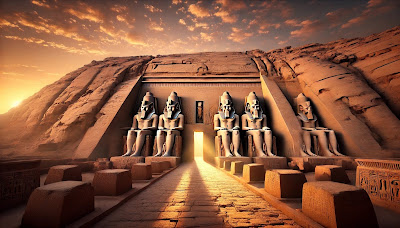Information about the sun’s perpendicularity to the Holy of Holies of King Ramesses’ Temple
The Sun’s Perpendicular Alignment with the Holiest of Places in King Ramesses II’s Temple: An Astronomical Marvel of Ancient Egypt
The phenomenon of the sun's perpendicular illumination at the Great Temple of Abu Simbel, located in southern Egypt, is one of the most celebrated architectural and astronomical achievements of the ancient world. Built during the reign of Pharaoh Ramesses II (r. 1279–1213 BCE), this temple is a testament to the skill and ingenuity of Egyptian engineers and a manifestation of Ramesses II’s divine authority. Twice each year, sunlight penetrates the temple's innermost sanctuary, illuminating the gods' figures and the king himself. This extraordinary event reflects Egypt’s advanced knowledge of astronomy and the deep interplay between architecture, religion, and royal ideology in the New Kingdom period.
Historical Context of the Temple of Ramesses
The temple of Abu Simbel, constructed around 1264 BCE during the 19th Dynasty, was carved into a cliff along the banks of the Nile River in Nubia, an area vital to Egypt’s imperial control and trade networks. This monumental structure was one of several temples Ramesses II commissioned to demonstrate Egypt's dominance and to honor himself and the gods. The temple’s location and scale conveyed a message of power to the people of Nubia and served as a reminder of Ramesses II’s divine right to rule.
At the heart of the Great Temple lies the inner sanctuary, which houses seated statues of four figures: Amun-Re, the king of the gods; Re-Horakhty, the sun god associated with cosmic order; Ramesses II, deified in his lifetime; and Ptah, the god of the underworld. The positioning and symbolism of these deities reflect a complex theological statement aligning the pharaoh with the divine order of the universe.
The Astronomical Phenomenon: Sunlight Illuminating the Sanctuary
Twice a year—on February 22 and October 22—the first rays of the rising sun travel through the length of the temple's axial corridor and strike the seated statues within the inner sanctuary. These dates are thought to mark significant events in the king's life: his coronation and possibly his birth, aligning his rule with the celestial movements.
During this event, the figures of Amun-Re, Re-Horakhty, and Ramesses II are bathed in light, while the statue of Ptah remains in shadow. This symbolic play of light reinforces the role of Ptah as a god associated with darkness and the underworld, while highlighting the sun's vital role in Egyptian religious and cosmological thought. The sun, embodying Re-Horakhty, is shown to bring life and divine blessing directly to the pharaoh, affirming the king's role as the intermediary between gods and humanity.
Architectural and Astronomical Precision
The precise alignment required to achieve this effect underscores the advanced knowledge of astronomy and engineering possessed by ancient Egyptian architects. The angle of the temple’s main axis and the positioning of its sanctuary were meticulously calculated based on careful observation of the sun’s movements throughout the year.
This phenomenon becomes even more remarkable considering the absence of modern instruments. The Egyptians relied on methods such as shadow tracking, star observation, and temple orientation techniques to design structures with a connection to the cosmos. The positioning of the Abu Simbel temple also capitalized on natural geography, enhancing its orientation and reinforcing its connection to the divine landscape of Nubia.
Symbolism and Religious Significance
In ancient Egyptian thought, the interaction between sunlight and sacred space held profound theological significance. The pharaoh was believed to embody the divine order or maat, ensuring cosmic balance and harmony. The biannual alignment of the sun symbolized the divine acknowledgment of Ramesses II’s role as the guarantor of this order.
The gods illuminated by the sun are no accident. Amun-Re, the supreme god of Thebes, represented creation and kingship, while Re-Horakhty was closely associated with the sun’s daily renewal. Ptah, left in shadow, maintained the balance between life and death, the known and the unknowable. Ramesses II’s inclusion in the tableau elevated him beyond mere mortals, into the pantheon of gods, eternalized in stone and sunlight.
Modern Discoveries and Restoration Efforts
The relocation of the Abu Simbel temples during the 1960s adds a modern layer to this ancient wonder. In response to the construction of the Aswan High Dam, which threatened to submerge the site under Lake Nasser, an international effort led by UNESCO disassembled the temples and rebuilt them 65 meters higher on an artificial hill. Engineers were tasked with preserving the solar phenomenon, which required complex astronomical calculations. Despite the relocation, the alignment remains intact, occurring one day later than originally intended due to the slight change in geographic position.
Today, this event draws thousands of visitors who gather to witness the alignment, underscoring the enduring fascination with the temple’s interplay of light, architecture, and religion.
Legacy of the Sun’s Perpendicular Alignment
The biannual alignment of the sun at Abu Simbel is a striking example of how the ancient Egyptians wove astronomy, architecture, and religion into a cohesive expression of power and faith. This phenomenon not only glorified Pharaoh Ramesses II but also affirmed the Egyptians’ place in the cosmic order.
Even now, millennia later, the Great Temple at Abu Simbel remains a source of awe and inspiration, reminding us of the achievements of one of history's most remarkable civilizations.
FAQs
- What is the Great Temple of Abu Simbel?
- What is the sun alignment phenomenon at Abu Simbel?
- When does the sun alignment occur?
- Why doesn’t sunlight illuminate Ptah?
- What does the sun alignment signify?
- How was the alignment achieved?
- What happened to Abu Simbel during the Aswan Dam construction?
- Did the relocation affect the sun alignment?
- Why are these specific gods depicted in the sanctuary?
- Can visitors witness the sun alignment today?



Comments
Post a Comment